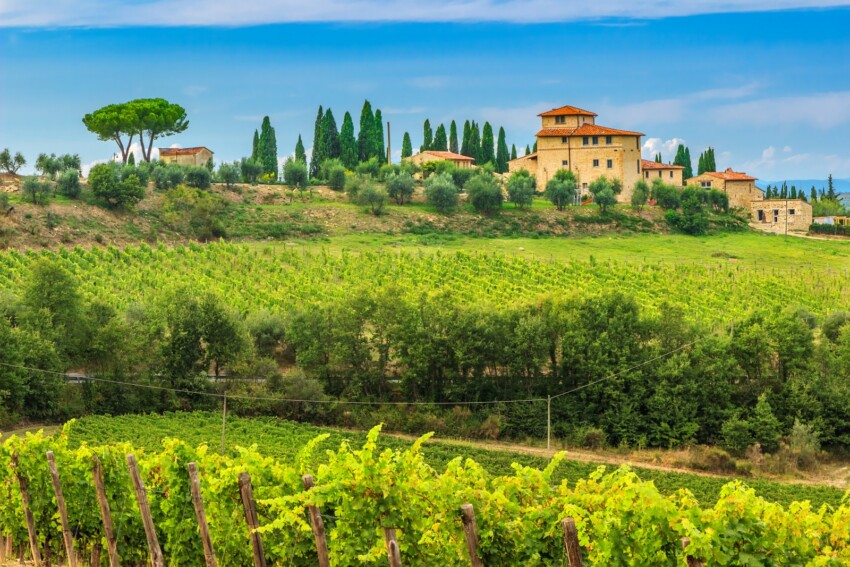

The Chianti region, with its succession of hilly landscapes of incomparable beauty, lies in the heart of Tuscany. Administratively divided between the provinces of Florence, Arezzo and Siena, during the Middle Ages it was bitterly contested between the two rival cities until the Medici imposed their hegemony over the whole of Tuscany in 1555.
It is difficult to draw its borders, since only the Chianti mountains to the east separate it clearly and naturally from the Upper Valdarno; the remaining territory fades into the hills of the Arbia, Elsa, Greve and Pesa.
Medieval villages, castles, churches, abbeys, monasteries, cottages and villas follow one another in a fantastic itinerary that exalts the industriousness and inventiveness of man; centuries of work have modelled the hills of this region and the alternation of vineyards with olive groves and woods creates a harmony unique in the world.
You can explore the Chianti region in complete freedom, moving from one town to another or following the two itineraries along the main routes through the region:
In any case, what visitors will be offered is an unforgettable landscape that is always varied and harmonious and so different in colour and atmosphere as the seasons change. There are numerous detours that can be made to reach a parish church, a castle or an isolated hamlet, silent witnesses to the historical and artistic richness of Chianti.
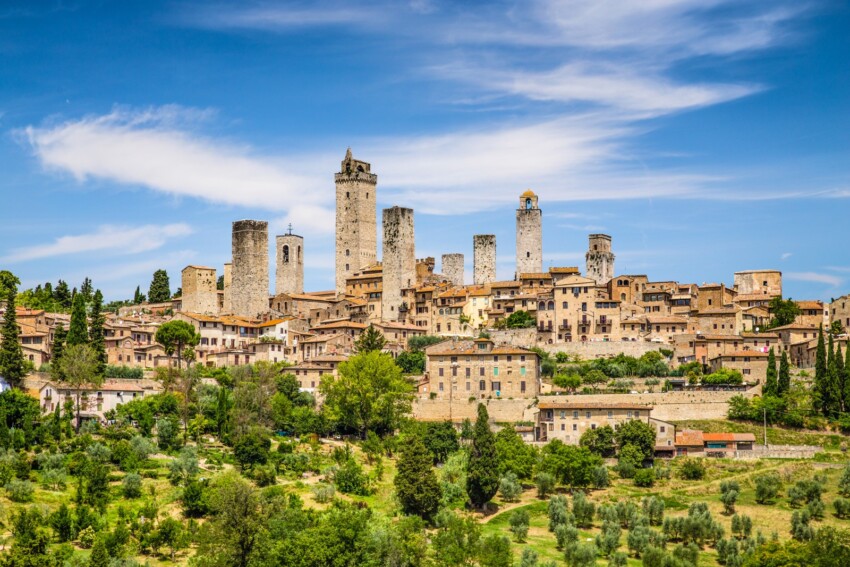
In the centre of Tuscany, close to the eastern part of Chianti, lies the Val d’Elsa, another area recommended for those who love the gentle Tuscan landscape and medieval atmospheres: here are some of the most beautiful villages in Tuscany.
One of these is San Gimignano: if you only have time to visit one village, head straight for this delightful hill town with its unmistakable medieval profile.
There are more than 10 towers rising from the centre of San Gimignano towards the sky, like mighty fingers of stone that seem to want to touch the blue. An exciting sight for those arriving, and just the prelude to the atmosphere of times gone by that awaits you as you stroll through the town centre.
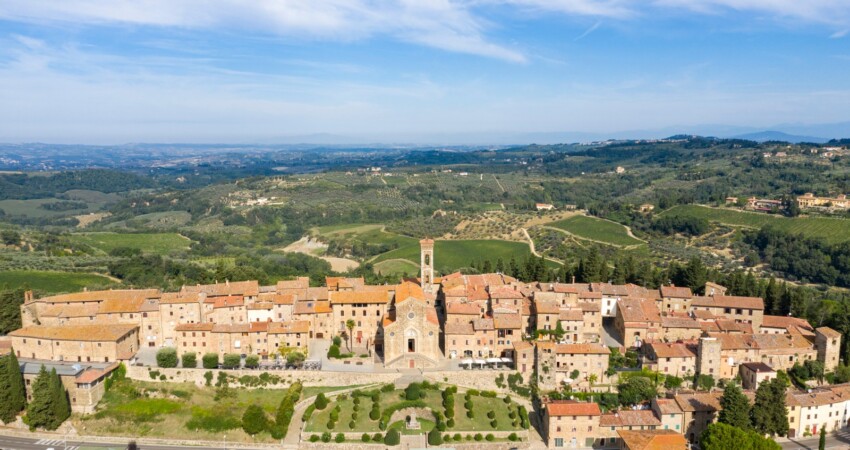
Founded by the Florentines in a strategic position to counter the expansion of the castle of Semifonte, Barberino Val d’Elsa still retains its medieval appearance with fortified walls, tower-houses, and some interesting buildings, including the Palazzo Pretorio (14th cent.), the Spedale dei Pellegrini (14th cent.) and the church of S. Bartolomeo.
From Barberino, following the road to Certaldo, you reach the remains of the Semifonte castle destroyed by the Florentines in 1202 after a long siege. Not far away, at the end of the 16th century, the chapel of St Michael Archangel was built to a design by Santi di Tito to commemorate Semifonte. Still in the direction of Certaldo is the Romanesque parish church of S. Appiano, one of the oldest in the Florentine countryside, dating back to around the 11th century. The cruciform pillars in front of the church are interesting, bearing witness to the existence of an ancient baptistery.
After Barberino Val d’Elsa, the Via Cassia continues, leaving Chianti behind. Those who wish to follow it can visit Poggibonsi, Colle Val d’Elsa and Monteriggioni and then reach Siena. A diversion from Poggibonsi to S. Gimignano is advisable.

A ‘border’ locality of Chianti, located south of the region, Castelnuovo Berardenga is an interesting place to visit. Its original nucleus dates back to the 9th century when it was a feudal complex with the name ‘terra berardinga’, but only a 14th-century tower and a section of wall remain of its ancient layout. Architecturally significant, however, is the Villa Chigi Saracini, with its large park, overlooking the village.
Also of interest are the Church of Saints Guido and Clemente (1843-1846), by Agostino Fantastici, commissioned by Count Agostino Saracini, and the Oratory of the Compagnia di Santa Maria del Patrocinio (1851-1860), by Andrea Chiusarelli, with its gabled, travertine and plaster façade, erected to honour a 14th-century polychrome terracotta depicting the Virgin Mary, whom the inhabitants of Castelnuovo Berardenga considered to be the patron saint of their community, attributing to the Madonna – called ‘del Patrocinio’ for this reason – the merit of having repeatedly safeguarded their land from invasions and wars.
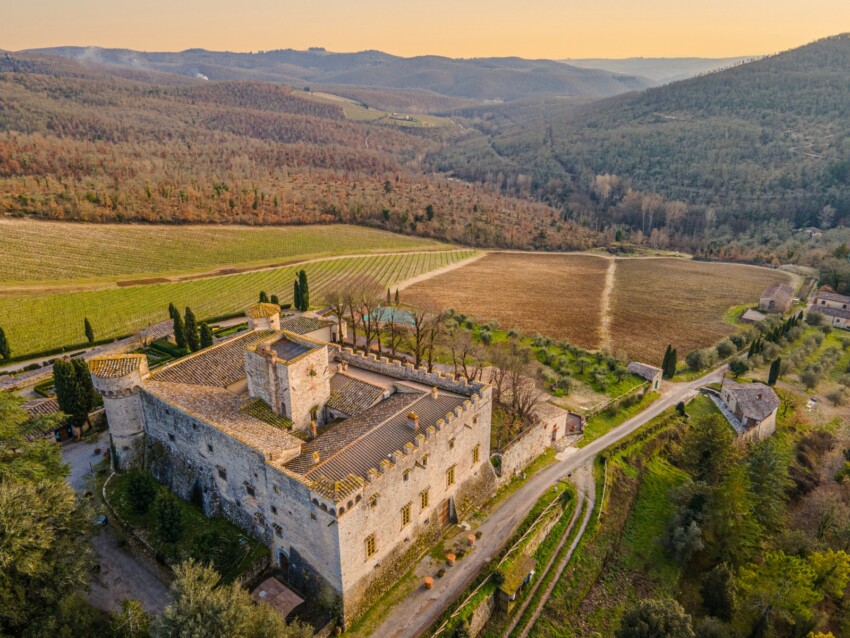
Gaiole in Chianti was an important medieval locality that developed along the road to Valdarno. The numerous castles and parish churches in the area bear witness to an intense and prosperous agricultural and commercial activity. Particularly interesting are the castle of Vertine, the castle of Meleto with two imposing round corner towers, the castle of Barbischio and, above all, the castle of Brolio, where a patrol walkway runs along the walls and bastions that surround it and from which one can enjoy a beautiful panorama of the Chianti and Sienese countryside. The castle, completely destroyed in 1478, was rebuilt in the last century at the behest of Bettino Ricasoli.
Less than 1 km from Gaiole, visit the beautiful Romanesque parish church of Spaltenna while, on the road to Valdarno, immersed in the green of centuries-old fir trees, the Badia a Coltibuono is worth a stop. Much of the imposing abbey complex built by the Vallombrosian monks in the 11th century is now privately owned; the Romanesque church with a massive crenellated bell tower remains.

On the border between the provinces of Florence and Siena, Radda in Chianti is an ancient village of medieval origin, of which only a few sections of walls and some towers remain. However, the 15th-century Palazzo Pretorio , adorned with podestà coats of arms, is interesting. Not far from Radda, in the direction of Lucarelli and Panzano, there is a sign for the Romanesque parish church of S. Maria Novella, unique in the Chianti area for its capitals decorated with zoomorphic symbols, monstrous figures and floral designs reminiscent of the Romanesque parish churches of Valdarno and Casentino.
Visit also the castle of Volpaia, a small medieval agglomeration where, within the walls, you will find a labyrinth of well-paved and preserved alleys among arches, palaces and the small Renaissance church of S. Eufrosino (15th cent.).
A hamlet of Greve in Chianti, Panzano is also a place not to be missed on a self-respecting Chianti tour. The historic village is located on the top of a hill, overlooked by the castle, which represents its original nucleus. It is still possible to observe the ancient walls, even though they have been remodelled over the centuries.
Today, the historic village, the so-called Panzano Alto, can be visited comfortably along two roads, which start from the small square and run parallel to the castle. Along both streets, of course, there is no lack of shops where you can taste the excellent wine produced in these parts. The buildings that overlook it are also very beautiful, late-medieval and Renaissance structures.

An ancient feud of the Trebbio family, Castellina in Chianti became a Florentine possession in the 15th century. It is to this period that the boundary walls and the fortress that dominates the town date back; but what testifies more than anything else to Castellina’s medieval past is undoubtedly Via delle Volte, a basement walkway of the walls whose slits offer exceptional views.
Just outside the town centre is the Etruscan hypogeum of Montecalvario, a tumulus rather imposing in size datable to the 7th-6th century B.C. that, together with other tombs found in various locations, bears witness to the Etruscan presence in Chianti. More distant instead, but still worthy of note, is the old castle of Monternano, the ruins of which can be visited.

Located at the crossroads of the roads that connected Florence to Siena and Valdarno Superiore to Valdelsa, today Greve in Chianti is in the province of Florence and is one of the main tourist destinations in Chianti. Its main square, with its original shape of an irregular triangle bordered by beautiful loggias, is still an important point of exchange, especially during the Mostra Mercato del Chianti Classico held every year in September.
Dominating Greve is the castle of Montefioralle , which still retains intact its original structure as a medieval village with a narrow road that twists and turns until it reaches the small church of S. Stefano, where an interesting 13th-century Madonna and Child is preserved. Also noteworthy are the castles of Uzzano, Verrazzano, Vicchiomaggio and Lamole. Not far from Greve, in the direction of Panzano, is the villa of Vignamaggio where, according to tradition, Mona Lisa, made famous by Leonardo, was born.
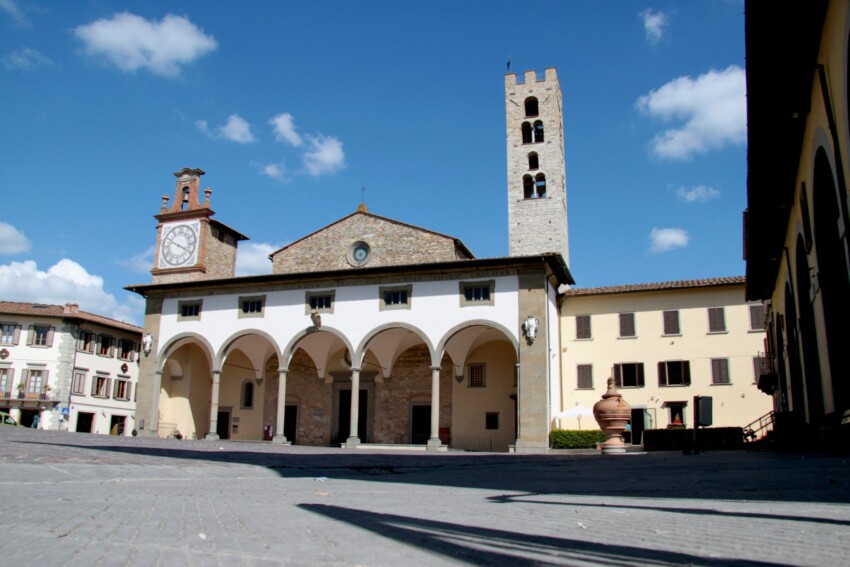
Already inhabited in Etruscan and Roman times, Impruneta is a municipality in the province of Florence that is well worth a visit. It is one of the gateways to the Chianti region, and once in town, do not miss the Pieve di S. Maria, founded in 1060 originally in Romanesque style, but which over the centuries has undergone numerous alterations so that only the original crypt has been preserved today, while the church has a sober Renaissance appearance. Inside, works by important artists such as Michelozzo and Luca della Robbia are preserved, and a miraculous icon of the Madonna is worshipped there, which tradition says was painted by the Evangelist Luke.
Over the centuries, the cult of the Madonna of Impruneta has favoured the accumulation of precious gifts and votive offerings, which are now preserved in the Museum of Sacred Art adjacent to the church, together with illuminated manuscripts, gold and silverware. Thanks to the great tradition of brick and terracotta kilns, Impruneta terracotta has become a characteristic and distinctive element of Tuscan architecture and landscape, as well as a famous product exported all over the world.
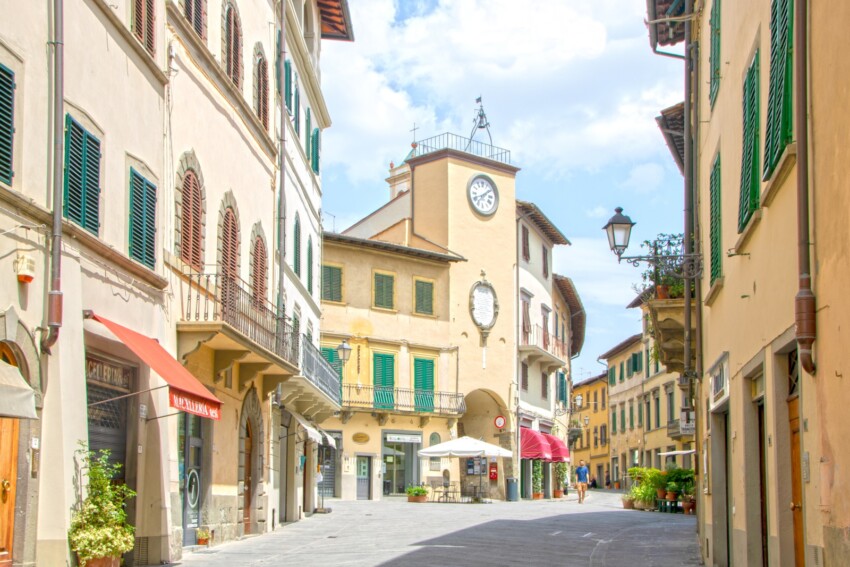
San Casciano Val di Pesa is located in the valley of the Pesa river, which runs through the Chianti region. It is a town on the outskirts of Florence, which is worth visiting to admire the traces of its walls and medieval towers.
The Museum of Sacred Art set up inside the Church of S. Maria del Gesù houses valuable works of art from the area: among the most important works are the dossal attributed to Coppo di Marcovaldo depicting Saint Michael Archangel and stories from his legend and the Madonna and Child by Lorenzetti. In the town, visit the main monuments, such as the Collegiate Church and the Church of the Misericordia (or S. Maria al Prato), which preserves a wealth of works of art, including a Crucifix by Simone Martini.
Tavarnelle owes its name to the ‘tabernulae’, places of rest and refreshment along the ‘via regia’ that joined Florence to Siena and then to Rome. The numerous churches and parish churches in the area are interesting, including the church of S. Lucia al Borghetto (13th cent.), a former Franciscan convent in Gothic style that preserves a valuable crucifix of the 14th-century school and an Annunciation by Neri di Bicci.
Just outside Tavarnelle, leaving the Via Cassia, you reach Morrocco where you can visit the church of S. Maria del Carmine, built in the 15th century and then extensively remodelled. Inside is a glazed terracotta Annunciation in the manner of Andrea della Robbia and a series of fragments of 15th-century frescoes. Not far from Morrocco is the ancient Romanesque parish church of S. Pietro in Bossolo, whose presbytery houses the Museum of Sacred Art, where works from the churches of the small abandoned nuclei are kept: among the most important works, we would like to point out a series of panels dated 1473 by Neri di Bicci for the church of S. Maria al Morrocco and an altarpiece with the Madonna and Child between S. Martin and S. Sebastian by the so-called Maestro di Tavarnelle.
Located in the municipality of Tavarnelle, San Donato in Poggio is certainly worth a visit during a Chianti tour. It is a mediaeval village that still retains notable remains of the town walls, 13th and 14th century buildings, the Renaissance Malaspina Palace, the Gothic-style church of S. Maria della Neve (15th century) and the Romanesque parish church of San Donato , which contains a beautiful glazed terracotta baptismal font by G. della Robbia.
North of San Donato, on the road from Sambuca to Greve, is the imposing Badia a Passignano, founded in 1049 by monks of the Vallombrosian order. Immersed in the countryside, surrounded by an intense cultivation of olive trees, the abbey is striking for its fortress-like appearance with its walls and crenellated towers. Among the numerous works of art preserved in the abbey are the frescoes by Passignano (1601) in the main chapel of the church and above all the Last Supper frescoed by Domenico and Davide Ghirlandaio (1476-77) in the monastery refectory.
In the following map you can see the location of the main places of interest mentioned in this article.
A selection of excellent facilities immersed in the Chianti countryside, an excellent base for your holiday.

Chianti wine is a true icon of Tuscany. Produced in the area of the same name, it has enjoyed DOCG recognition since 1984. Its production is subject to restrictions regarding grape varieties, in fact it must be made from at least 70% Sangiovese grapes , and at the same time Cabernet Franc and Cabernet Sauvignon grapes may not exceed 15%.
There are also certain rules that winegrowers must observe regarding production techniques, so that the product is always of excellent quality, with a lively ruby red colour and an intense aroma. Chianti wine is dry, savoury and tannic, and is produced in 7 sub-zones: Colli Aretini, Colli Fiorentini, Colli Senesi, Colline Pisane, Montalbano, Montespertoli and Rufina. It is produced in two types, riserva and superiore, and the noblest product is then designated with the label Chianti Classico.
Chianti wine producers are united within the Chianti Classico consortium, which has around 600 participants, and the Gallo Nero consortium, which promotes and enhances these wines. Today, although the ministerial decree of 1967 recognised only one controlled designation of origin for Chianti, Chianti Classico is more strictly regulated.
The reason why Chianti wine has a black rooster as its symbol goes back to an ancient legend: at the time when Florence and Siena were fighting to redraw their borders, the two republics decided to challenge each other. At the crowing of the rooster, a horseman would set out from Florence towards Siena, and vice versa: the meeting point would mark the new border. It is said that the two knights met at the castle of Fonterutoli, and the border was established at nearby Castellina in Chianti.